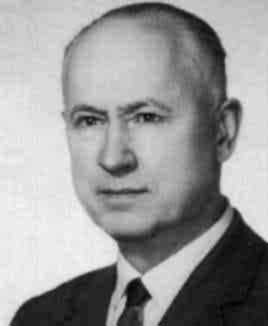Karol Borsuk: Difference between revisions
It is added that Andrzej Granas was a student of: Karol Borsuk |
No edit summary |
||
| Line 18: | Line 18: | ||
|academic_advisors = |
|academic_advisors = |
||
|doctoral_students = |
|doctoral_students = |
||
|notable_students = [[Samuel Eilenberg]],Andrzej Granas, Jan Jaworowski, |
|notable_students = [[Samuel Eilenberg]],Andrzej Granas, [[Jan Jaworowski]], [[Hanna Patkowska]], [[Krystyna Kuperberg]] |
||
|known_for = [[Borsuk's conjecture]]<br>[[Borsuk–Ulam theorem]] |
|known_for = [[Borsuk's conjecture]]<br>[[Borsuk–Ulam theorem]] |
||
|author_abbrev_bot = |
|author_abbrev_bot = |
||
| Line 35: | Line 35: | ||
Borsuk introduced the theory of ''absolute retracts'' (ARs) and ''absolute neighborhood retracts'' (ANRs), and the [[cohomotopy group]]s, later called Borsuk–[[Edwin Spanier|Spanier]] cohomotopy groups. He also founded the so-called [[Shape theory (mathematics)|Shape theory]]. He has constructed various beautiful examples of topological spaces, e.g. an acyclic, 3-dimensional continuum which admits a fixed point free homeomorphism onto itself; also 2-dimensional, contractible polyhedra which have no free edge. His topological and geometric conjectures and themes stimulated research for more than half a century. |
Borsuk introduced the theory of ''absolute retracts'' (ARs) and ''absolute neighborhood retracts'' (ANRs), and the [[cohomotopy group]]s, later called Borsuk–[[Edwin Spanier|Spanier]] cohomotopy groups. He also founded the so-called [[Shape theory (mathematics)|Shape theory]]. He has constructed various beautiful examples of topological spaces, e.g. an acyclic, 3-dimensional continuum which admits a fixed point free homeomorphism onto itself; also 2-dimensional, contractible polyhedra which have no free edge. His topological and geometric conjectures and themes stimulated research for more than half a century. |
||
Borsuk received his [[master's degree]] and [[doctorate]] from [[Warsaw University]] in 1927 and 1930, respectively; his [[Ph.D.]] thesis advisor was [[Stefan Mazurkiewicz]]. He was a member of the [[Polish Academy of Sciences]] from 1952. Borsuk's students included [[Samuel Eilenberg]], Andrzej Granas, Jan Jaworowski, [[Krystyna Kuperberg]], [[Włodzimierz Kuperberg]], Włodzimierz Holsztyński, |
Borsuk received his [[master's degree]] and [[doctorate]] from [[Warsaw University]] in 1927 and 1930, respectively; his [[Ph.D.]] thesis advisor was [[Stefan Mazurkiewicz]]. He was a member of the [[Polish Academy of Sciences]] from 1952. Borsuk's students included [[Samuel Eilenberg]], Andrzej Granas, [[Jan Jaworowski]], [[Hanna Patkowska]], [[Krystyna Kuperberg]], [[Włodzimierz Kuperberg]], Włodzimierz Holsztyński, |
||
[[Andrzej Trybulec]] and Jerzy Dydak, |
[[Andrzej Trybulec]] and Jerzy Dydak, |
||
Revision as of 07:26, 9 September 2014
Karol Borsuk | |
|---|---|
 | |
| Born | May 8, 1905 |
| Died | January 24, 1982 (aged 76) Warsaw, Poland |
| Nationality | Polish |
| Alma mater | Warsaw University |
| Known for | Borsuk's conjecture Borsuk–Ulam theorem |
| Scientific career | |
| Fields | Mathematics |
| Doctoral advisor | Stefan Mazurkiewicz |
| Notable students | Samuel Eilenberg,Andrzej Granas, Jan Jaworowski, Hanna Patkowska, Krystyna Kuperberg |
Karol Borsuk (May 8, 1905 – January 24, 1982) was a Polish mathematician. His main interest was topology.
Borsuk introduced the theory of absolute retracts (ARs) and absolute neighborhood retracts (ANRs), and the cohomotopy groups, later called Borsuk–Spanier cohomotopy groups. He also founded the so-called Shape theory. He has constructed various beautiful examples of topological spaces, e.g. an acyclic, 3-dimensional continuum which admits a fixed point free homeomorphism onto itself; also 2-dimensional, contractible polyhedra which have no free edge. His topological and geometric conjectures and themes stimulated research for more than half a century.
Borsuk received his master's degree and doctorate from Warsaw University in 1927 and 1930, respectively; his Ph.D. thesis advisor was Stefan Mazurkiewicz. He was a member of the Polish Academy of Sciences from 1952. Borsuk's students included Samuel Eilenberg, Andrzej Granas, Jan Jaworowski, Hanna Patkowska, Krystyna Kuperberg, Włodzimierz Kuperberg, Włodzimierz Holsztyński, Andrzej Trybulec and Jerzy Dydak,
See also
- Borsuk's conjecture
- Borsuk–Ulam theorem
- Zygmunt Janiszewski
- Stanislaw Ulam
- Scottish Café
- Animal Husbandry, an educational dice game published by Borsuk at his own expense in 1943 during the German occupation of Warsaw.
Works
- Geometria analityczna w n wymiarach (1950)
- Podstawy geometrii (1955)
- Foundations of Geometry (1960) with Wanda Szmielew, North Holland publisher[1]
- Theory of Retracts (1967), PWN, Warszawa.
- Theory of Shape (1975)
- Collected papers vol. I, (1983), PWN, Warszawa.
References
- ^ Freudenthal, H. (1961). "Review: Foundations of geometry, Euclidean and Bolyai-Lobachevskian geometry, projective geometry. By K. Borsuk and Wanda Szmielew. Revised English translation" (PDF). Bull. Amer. Math. Soc. 67 (4): 342–344. doi:10.1090/s0002-9904-1961-10606-x.
External links
- O'Connor, John J.; Robertson, Edmund F., "Karol Borsuk", MacTutor History of Mathematics Archive, University of St Andrews
- Karol Borsuk at the Mathematics Genealogy Project